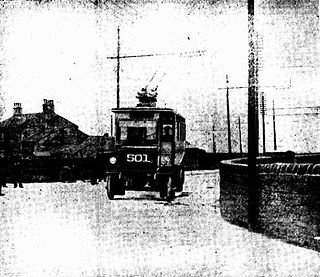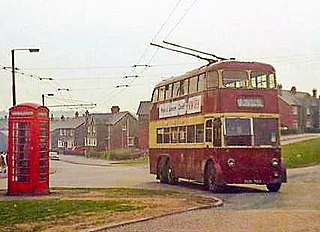| Hobart trolleybus system | |
|---|---|
 Hobart's first trolleybus, 1935. | |
| Operation | |
| Locale | Hobart, Tasmania, Australia |
| Open | 29 October 1935 |
| Close | 24 November 1968 |
| Status | Closed |
| Routes | 6 (max) |
| Operator(s) | City of Hobart Municipal Tramways Trust Metropolitan Transport Trust |
| Infrastructure | |
| Depot(s) | Davey Street |
| Stock | 69 (max) |
| Statistics | |
| Route length | 17.75 mi (28.57 km) |
The Hobart trolleybus system was part of the public transport network in Hobart, the capital city of Tasmania, Australia, for more than 30 years in the mid-twentieth century.

A trolleybus is an electric bus that draws power from overhead wires using spring-loaded trolley poles. Two wires, and two trolley poles, are required to complete the electrical circuit. This differs from a tram or streetcar, which normally uses the track as the return path, needing only one wire and one pole. They are also distinct from other kinds of electric buses, which usually rely on batteries. Power is most commonly supplied as 600-volt direct current, but there are exceptions.

Public transport is a system of transport for passengers by group travel systems available for use by the general public, typically managed on a schedule, operated on established routes, and that charge a posted fee for each trip. Examples of public transport include city buses, trolleybuses, trams and passenger trains, rapid transit and ferries. Public transport between cities is dominated by airlines, coaches, and intercity rail. High-speed rail networks are being developed in many parts of the world.

Hobart is the capital and most populous city of the Australian island state of Tasmania. With a population of approximately 240,000, it is the least populated Australian state capital city, and second smallest if territories are taken into account. Founded in 1804 as a British penal colony, Hobart, formerly known as Hobart Town or Hobarton, is Australia's second oldest capital city after Sydney, New South Wales. Prior to British settlement, the Hobart area had been occupied for possibly as long as 35,000 years, by the semi-nomadic Mouheneener tribe, a sub-group of the Nuennone, or South-East tribe. The descendants of these Aboriginal Tasmanians often refer to themselves as 'Palawa'.
















